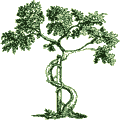
|
|||||||
Toe Deformities in Children
- Hallux valgus. This is a common deformity,
where the great toe is deviated laterally to overlap the 2nd toe, and
the first metatarsal bone is deviated medially, causing a prominence
to form on the medial aspect of the metatarso-phalangeal joint (MTP
joint). A bursa forms over the area as a result of the constant irritation
and inflammation, forming a painful bunion.
There may be some degree of foot pronation (flat feet) associated with
the condition. Many factors come into play to cause the problem, including
foot structure which may or may not be hereditary, and use of narrow
stylized shoes that crimp the toes. Most cases are mild and asymptomatic,
and do not need treatment. These patients should be counseled in wearing
shoes with lots of toe room and no heels. If there is flat feet, a shoe
insert to correct the foot pronation may help to prevent progression
of the disease. In the more severe cases, surgical correction may be
needed.
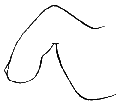
- Hammer Toe. The deformity occurs at the Proximal
interphalangeal joint (PIP). In an infant, it is usually due to hereditary
factors. In the older child, it could be due to faulty shoe wear. Make
sure the child has roomy shoes that allow the toes to stretch. Most
cases are mild, cause no pain, and can be left alone. In the more severe
cases, at an older age, surgical correction may be needed.

- Mallet Toe. The deformity occurs at the Distal
interphalangeal joint (DIP). Most cases are mild, and need no treatment.
If a corn develops over the deformity, shaving and padding will help.
In the more severe cases, surgical correction can be done.

- Claw Toe. The deformity involves all joints
of the toe - hyperextension of the MTP joints, and flexion at both the
PIP and DIP joints. It is a rare condition, but usually occurs in conjunction
with a cavus foot, present in neuromuscular diseases like Charcot-Marie-Tooth
disease or myelomeningocele.
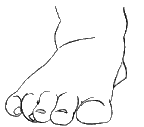
- Curly Toe. The affected toe, usually the 4th or 5th toe is flexed downward and twisted underneath the adjacent toe. It is quite common in infancy and childhood. If it does not cause symptoms, no treatment is needed. If severe, and causes irritation with shoe wear, surgical transfer of the toe flexor may correct the problem.
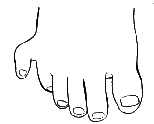
- Extra toe (or Polydactyly). If the extra toe is not causing problems with walking and shoe wear, no treatment is needed. If the duplication occurs in the little or big toe, and sticks out prominently, surgical excision will remove the problem.
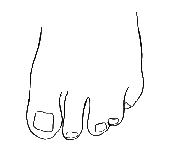
- Webbed Toes (or Syndactyly) is quite common, and rarely causes problems. Unlike in the fingers, where surgical separation is needed to obtain finer hand functions, syndactyly in the toes does not need treatment.
- Bunionette (or Tailor's Bunion). The pathology is like that in a bunion, except that it occurs at the 5th metatarso-phalangeal joint. The bursa over the lateral aspect of the 5th MTP joint gets prominent and inflamed and painful. If padding does not help, surgical correction is needed.
- Curly Toe. The affected toe, usually the 4th or 5th toe is flexed downward and twisted underneath the adjacent toe. It is quite common in infancy and childhood. If it does not cause symptoms, no treatment is needed. If severe, and causes irritation with shoe wear, surgical transfer of the toe flexor may correct the problem.
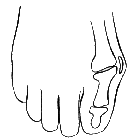
NOTICE: The information presented is for your information only, and not a substitute for the medical advice of a qualified physician. Neither the author nor the publisher will be responsible for any harm or injury resulting from interpretations of the materials in this article.
Questions
or comments? Post your thoughts in the Orthoseek
Message Forum!
Find a pediatric orthopedic surgeon
in an area near you.
Home | About Us | Orthopaedic Topics | Message Forum
![]()
Comments, questions, or suggestions are welcome. Please
contact us using this form.